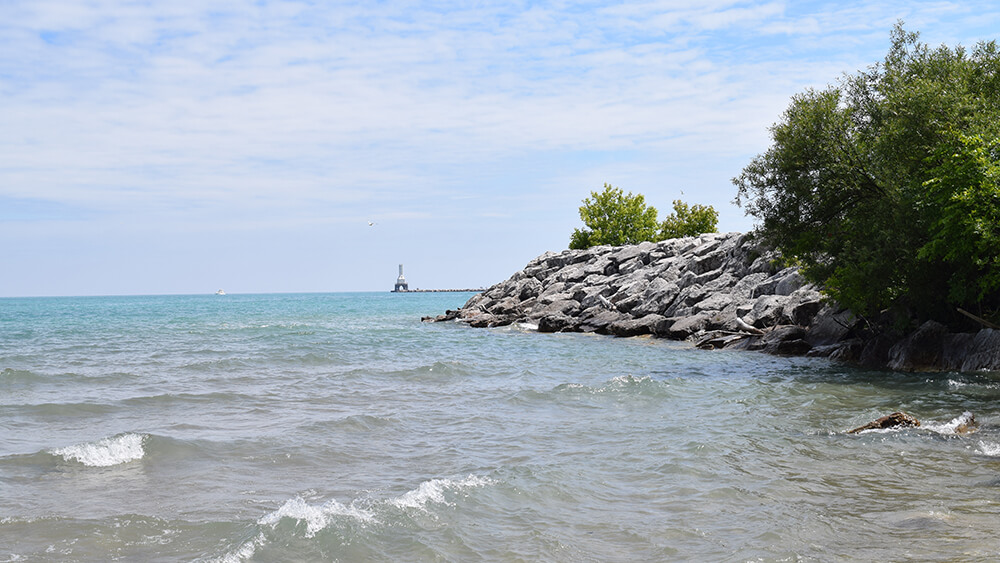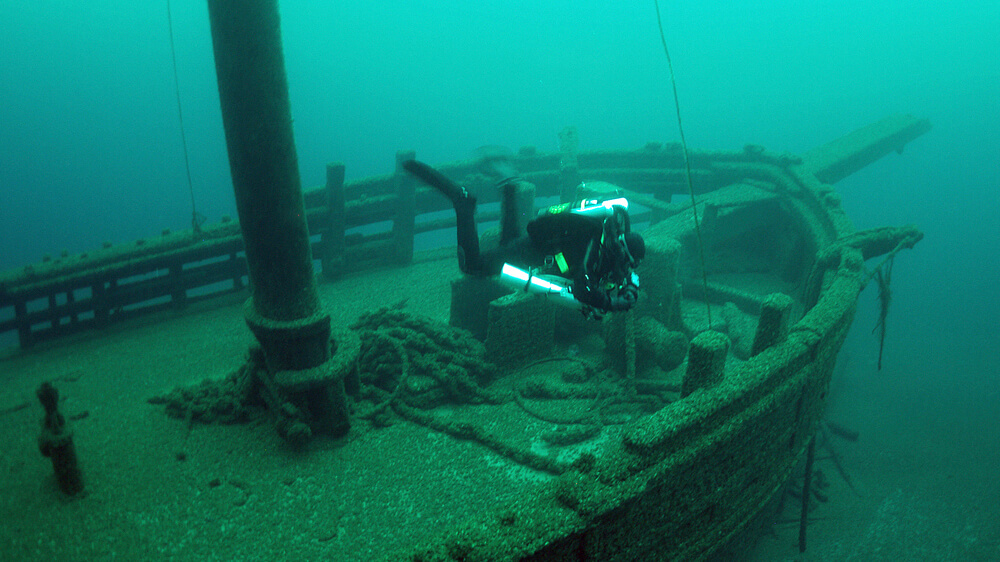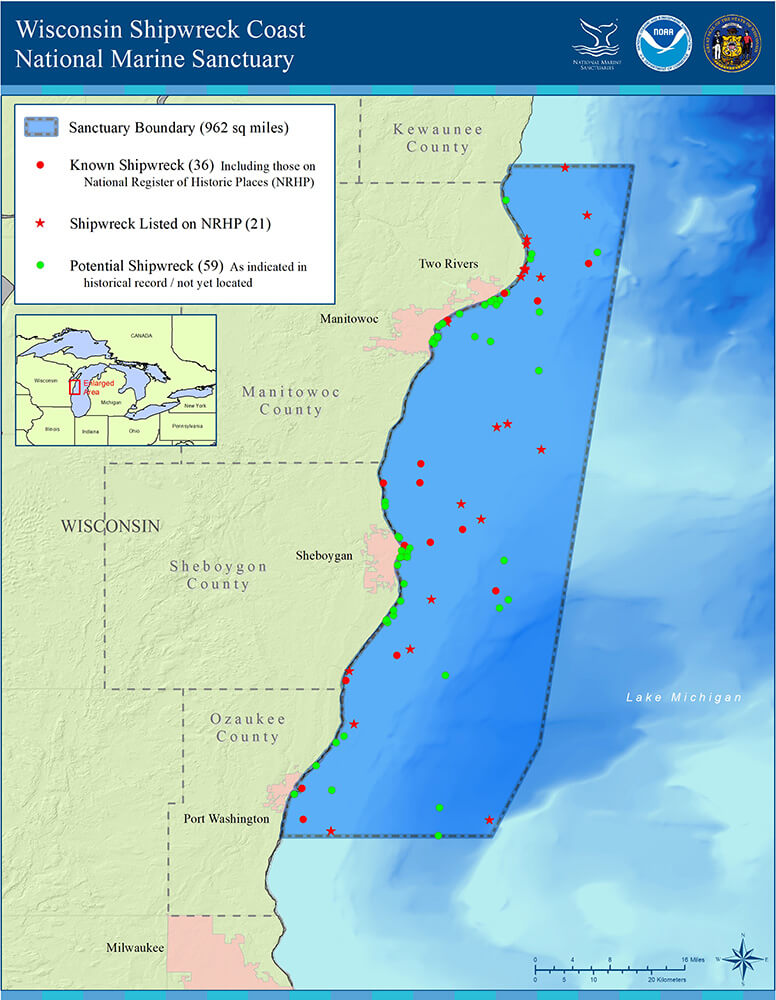NOAA Announces New National Marine Sanctuary in Lake Michigan
By Rachel Plunkett
June 2021
Preserved for centuries by the cold, fresh water of Lake Michigan, 36 historically significant shipwrecks are now protected within a new national marine sanctuary co-managed by NOAA and the state of Wisconsin.
The 962-square mile area of Lake Michigan, named Wisconsin Shipwreck Coast National Marine Sanctuary, was designated this month by NOAA with widespread support from a diverse coalition of organizations and individuals at local, state, regional, and national levels. The sanctuary will protect and celebrate the region’s maritime cultural heritage while creating unique research, educational, recreational, and tourism opportunities.
The designation will officially take effect following publication of this action in the Federal Register and a 45-day review by Congress and the governor of Wisconsin.
Spanning the 1800s through the early 20th century, the sanctuary's shipwrecks represent a cross-section of vessels that played an essential role in the growth of the nation. These hard-working sailing vessels, revolutionary passenger ships, and steel-hulled freighters transported America’s business and industry to the Eastern Seaboard and beyond. In the process, they brought thousands of people to Wisconsin and made possible the dramatic growth of the Midwest’s farms, cities, and industries. Twenty-one of the shipwrecks are listed on the National Register of Historic Places, including Wisconsin’s two oldest known shipwrecks dating to the 1830s.
“We’re really excited about NOAA’s announcement,” said Wisconsin Governor Tony Evers. “The designation builds on 30 years of maritime heritage preservation by the state of Wisconsin and will create exciting new opportunities in education, recreation, and tourism in our coastal communities.”
While it has been in the works for several years, the announcement of this designation comes shortly after President Biden’s Conserving and Restoring America the Beautiful initiative was launched -- a roadmap for inclusive and locally led efforts to conserve at least 30% of U.S. lands and waters by 2030.
A Collaborative Effort to Preserve our National Heritage
Schooners pack the Manitowoc River in 1890. Photo: Wisconsin Maritime Museum/Carus Collection
Lake Michigan, the second largest of the five Great Lakes, encompasses over 22,000 square miles. Locals and visitors alike are drawn to its beautiful waters, which are rich with maritime history and recreational opportunities. The new sanctuary is built on a strong community foundation forged by years of stakeholder collaboration -- including elected officials, businesses, museums, and environmental, recreational, conservation, tourism, and educational groups.
“Designating Wisconsin Shipwreck Coast National Marine Sanctuary allows us to preserve and interpret an important chapter in our nation’s history, and also support the communities to which Lake Michigan means so much, socially and economically,” said John Armor, director of NOAA’s Office of National Marine Sanctuaries. “Our team, NOAA, the state of Wisconsin, and our many partners are so proud of this moment and the new opportunities for education, research, recreation, and tourism on and off the water.”

The sanctuary was nominated in December 2014 by the governor of Wisconsin on behalf of the state of Wisconsin; the cities of Two Rivers, Manitowoc, Sheboygan, and Port Washington; and Manitowoc, Sheboygan, and Ozaukee counties. In October 2015, NOAA announced its intent to designate the sanctuary to help conserve nationally significant shipwrecks and maritime heritage resources. The proposal was shaped with significant public input. The final rule incorporates considerations from public comments, as well as consultations with the state of Wisconsin and tribal nations.
“The City of Manitowoc has worked toward this day for 12 years along with many wonderful partners at NOAA, the National Marine Sanctuary Foundation, the state of Wisconsin, and our municipal partners. We are excited that Wisconsin Shipwreck Coast National Marine Sanctuary will finally be a reality,” said Justin Nickels, mayor of Manitowoc.
Shipwrecks
Built in 1843 the schooner, Home, is one of the oldest shipwrecks discovered in Wisconsin. Photo: Tamara Thomsen/Wisconsin Historical Society
The collection of shipwrecks within Wisconsin Shipwreck Coast National Marine Sanctuary is considered a national treasure because of the excellent preservation and archaeological condition of the shipwrecks, their diverse roles in the development of the Midwest and the rest of the nation, and their location on a historically significant transportation corridor. In addition to the shipwrecks themselves, many of their cargos remain largely intact: from general merchandise and locally produced goods, to Christmas trees and 264 Nash automobiles from 1929.
An extraordinary example is the schooner Walter B. Allen (1866-1880) -- a boxy-hulled “canaller,” once used to transport grain and coal between New York and Chicago. Canallers like this one are iconic because they were unique to the Great Lakes and were constructed to fit perfectly through the Welland Canal Locks. Sitting upright on the lakebed at a depth of 165 feet, the 136-foot long wooden schooner is still intact. Sites like this create exceptional recreational scuba diving opportunities for adventure-seekers and history buffs from across the globe, and contain a wealth of archaeological information.

An estimated 60 ships may yet to be discovered within the boundaries of the new sanctuary, in addition to the 36 known shipwreck sites. The potential for discovery is one of the most exciting aspects of the new sanctuary. The sanctuary and its partners have already begun the search, and in the process are creating new detailed maps of the lakebed, which can be viewed online. The maps also provide new information about the lake’s natural environment.
Engaging the Community
Milwaukee-based tallship Denis Sullivan visits Sheboygan during a 2017 Get in Your Sanctuary event. Photo: Matt McIntosh/NOAA
The sanctuary will provide a national stage for local communities to promote heritage tourism and recreation, attract new partners and resources, and bring attention and action to broader Lake Michigan conservation issues. The sanctuary will partner with cultural institutions, local and state tourism bureaus, conservation organizations, educators, and others to create new ways to connect the public with our nation’s heritage.
“The research, resources, and national exposure that the sanctuary brings to our incredible maritime story, illustrated by the underwater museums on the bottom of Lake Michigan, will benefit our communities, our citizens, and certainly the invaluable cultural treasures that are Wisconsin’s Great Lakes shipwrecks,” said Catherine Green, executive director of the Wisconsin Maritime Museum.
An important link between the sanctuary and communities is the creation of a Sanctuary Advisory Council, which will bring together diverse community members to provide advice to the sanctuary superintendent on the management and protection of the sanctuary.
Rachel Plunkett is the writer/editor for NOAA’s Office of National Marine Sanctuaries.


